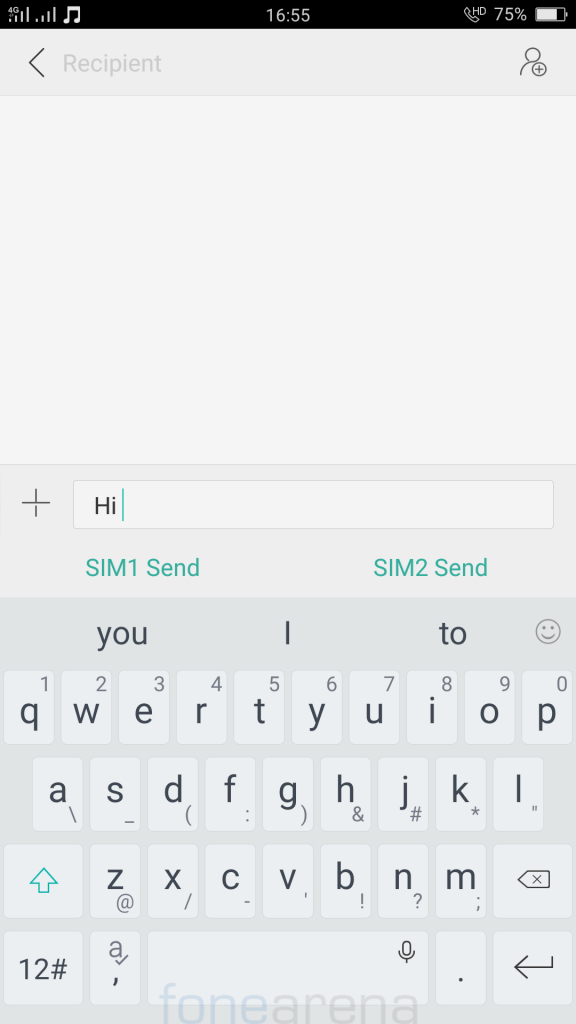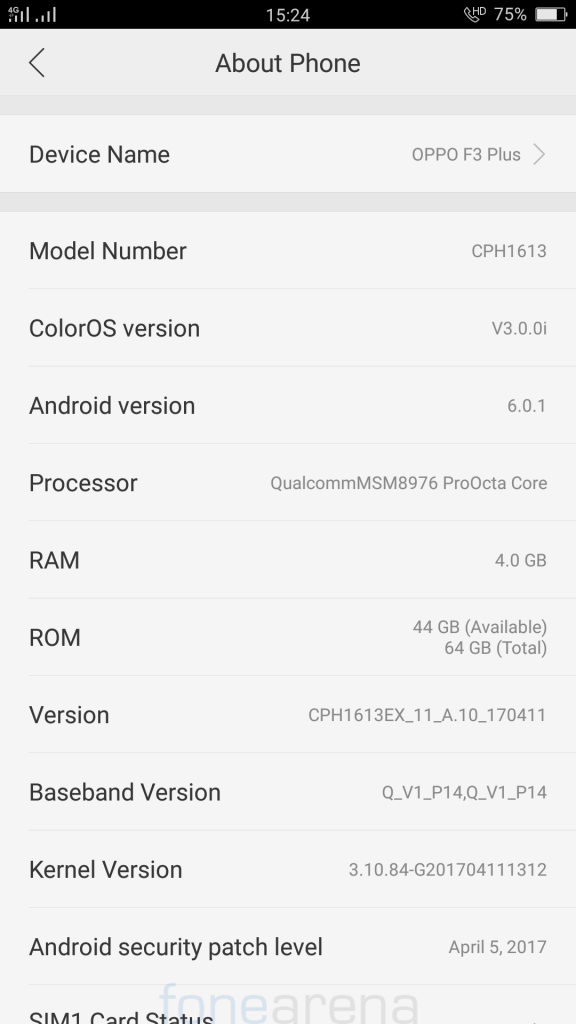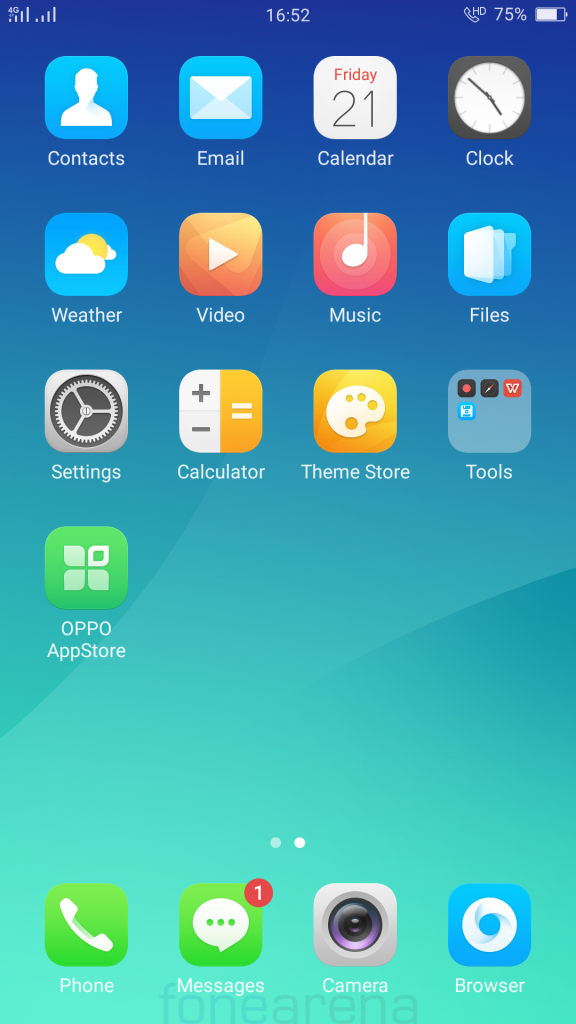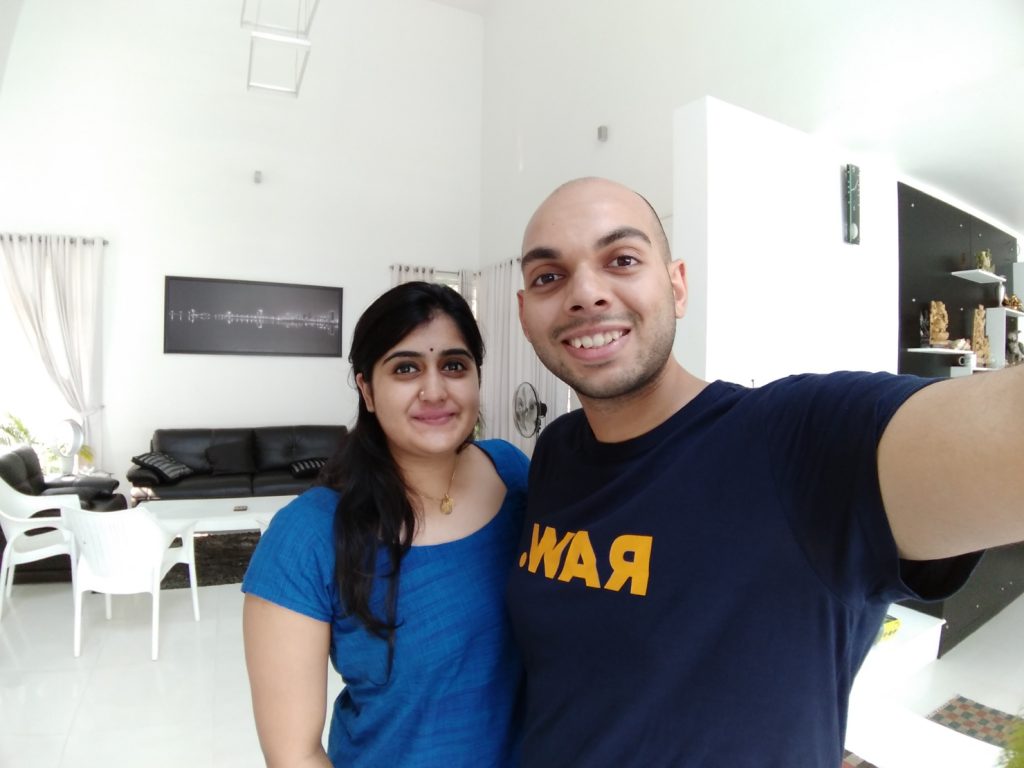
OPPO are investing heavily into the selfie game. There is a huge demand for selfie centric smartphones in China and lately India too has been showing similar signs. I have seen several users buying smartphones solely due to the focus on selfies. However, as a smartphone, there are several other parameters to be considered in order to truly gauge the value of a smartphone and that is exactly what we will be doing in this review.
Design, Materials and Build Quality
Every company has a design philosophy that is pretty much apparent across all their products. OPPO has been following one such design language in the recent past and the F3 Plus is no exception. A quick look at the F3 Plus and you are immediately reminded of its predecessor, the F1s.

In fact, to the untrained eye, it is almost identical to the F1s from the front. The only signs stating otherwise are the number of cameras at the front as well as the larger footprint which again only becomes apparent when you have handled both devices or when you put them side by side.

The front is dominated by the huge 6 inch display which is a step up from the already massive 5.5″ display on the predecessor. The bezels too are pretty substantial at the top and bottom. However, that could be forgiven to a certain extent especially above the display since it houses dual camera, an earpiece and the ambient light as well as proximity sensors.

Below the display, you get the home button with a fingerprint sensor housed inside it and two capacitive keys on either side.

At the bottom, you have the speaker, primary microphone, audio jack and the microUSB port while you have a solitary microphone at the top.

The right side houses the Hybrid Dual SIM tray and the power key while you find the volume rocker buttons on the left side. No special grooving or patterns on any of the keys here but that is fine since the power key and volume rocker buttons aren’t placed on the same side.
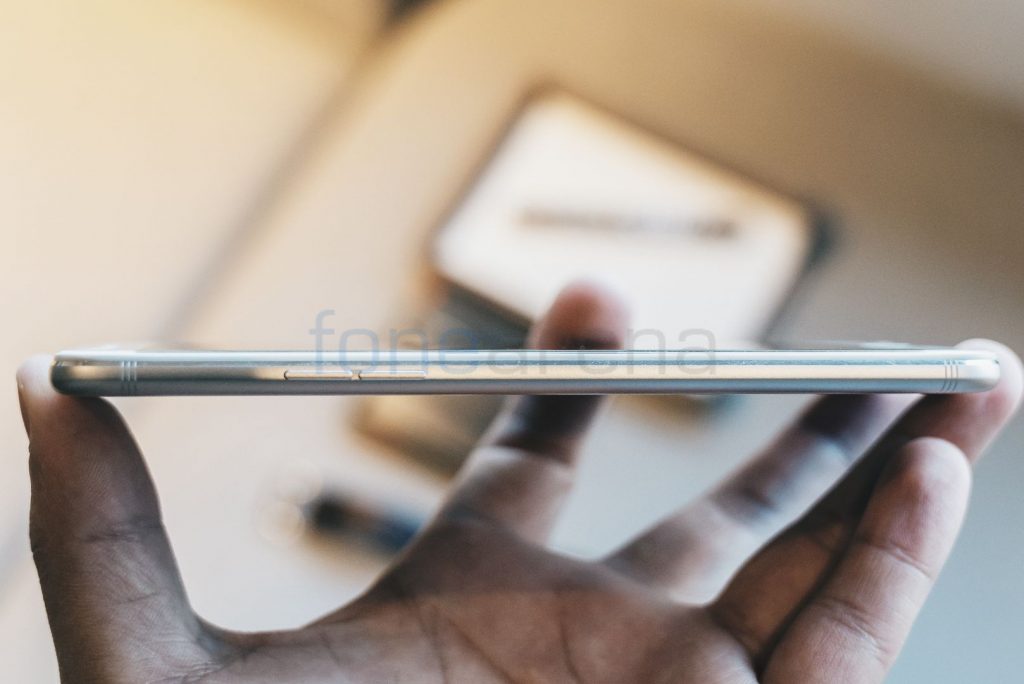
The back of the phone is again very familiar however is still different since it is all metal. There aren’t any plastic cutouts or portions at the top and bottom to facilitate for better wireless and cellular reception. Yes, there are still antenna lines but they are quite minimal and the tri-antenna design looks more of an aesthetic choice rather than a functional one even though it is the other way around.

Apart from the antenna lines, some regulatory information and the OPPO branding, you only find the camera lens and the flash module here. The F3 Plus is not the smallest of devices around. The bezels are pretty big and the device is also a bit heavy at 185 grams. However, the weight distribution is done well and masks the true weight of the device. Handling wise too, it wasn’t as cumbersome as some of the older 6 inch devices from OPPO of the past. I remember the behemoth OPPO N1 and even the smaller 5.5″ OPPO N3 was pretty tough to handle especially due to the thickness that was 9mm and 9.9mm respectively.

The F3 Plus features curved edges and a 7.4mm slim frame that helps to mask the sheer size to a large extent. However, for the most part, it is still a device that 90% of the people will be comfortable with using with 2 hands. The upcoming OPPO F3 will cater to those of you who don’t want to stretch their hands or rely on using 2 hands for comfortable use.
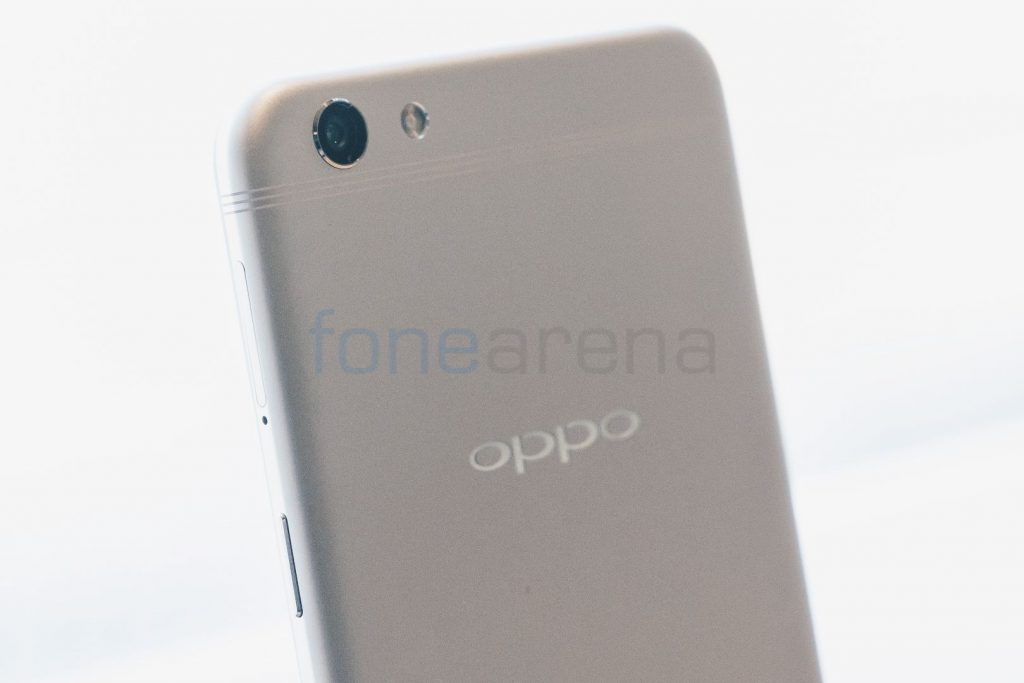
The F3 Plus comes in Gold and Pink both of which have a white colour front fascia. It goes well with both the colours so there is nothing to complain here. Having matching coloured front fascias wouldn’t look good. However, my favourite from the bunch is the Black Edition F3 Plus which looks really stealthy and amazing. It even masks the antenna lines very well and provides superior grip.
Display
The F3 Plus packs a 5.5″ 1080p IPS display with Corning Gorilla Glass 5 for protection. The glass is 2.5D and is really impressive especially for a phone at this price range. It also does a good job at keeping scratches at bay and should even be stronger than previous generation GG in terms of drop protection.

In terms of resolution, 108p isn’t bad but you can’t just hope but feel that they could’ve included a 1440p panel since it is a multimedia oriented smartphone. Yes, it would have an effect on the battery life but the phone does have a large 4000 mAh battery under the hood. The display offers good viewing angles and vividness. Brightness levels are more than sufficient indoors as well.
However, when it comes to sunlight legibility, the phone fails. The brightness levels are sometimes insufficient outdoors and the highly reflective glass also doesn’t help the cause. It will take some squinting to see the elements on the screen on a bright and sunny day. The eye protection display mode allows you to enable the blue light filter that in turns protects your eyes and reduces the strain on your brain. The screen also supports scaling to make the entire screen area small so that you can use it with one hand. It even has gesture screenshot and you can adjust the font and its size as well.
Fingerprint Scanner
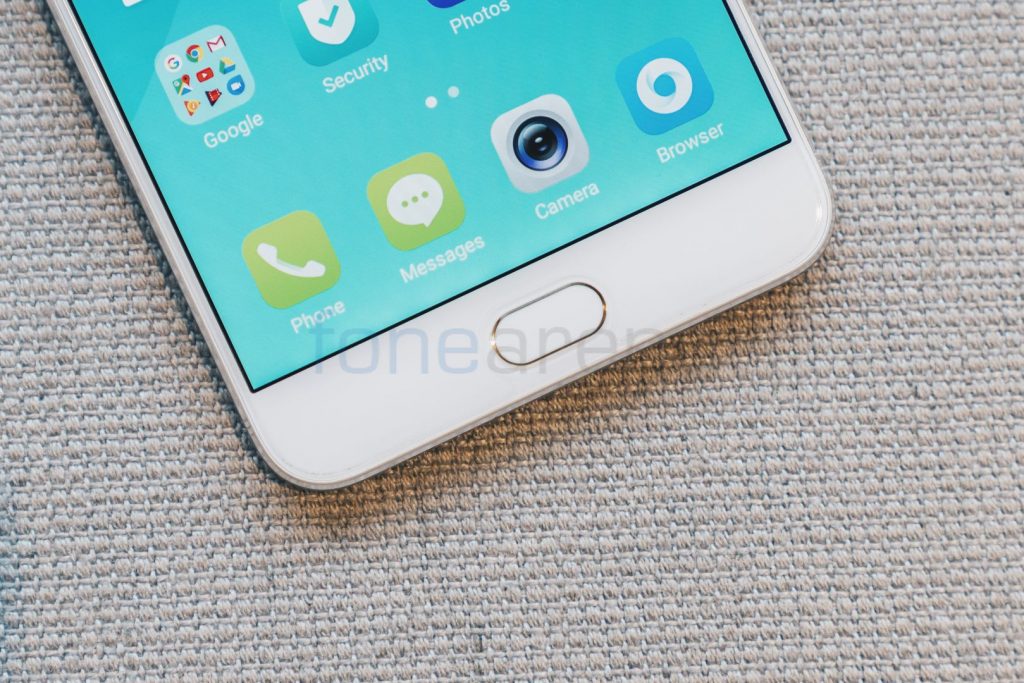
The fingerprint scanner on the F3 Plus is mounted at the front, within the home button. Unlike the F1s, the home button on the F3 Plus isn’t clickable. Instead, you get a touch sensitive button that does provide haptic feedback. The fingerprint scanner is quite fast and accurate.
It also recognizes your fingers even if there’s moisture or sweat on the sensor or your finger; to a certain extent at least. The fingerprint sensor is always active and you do not necessarily have to wake up the device before unlocking it even though you can do that as well.
Calls and Messaging

The OPPO F3 Plus offers good sound quality and loudness through the earpiece while calling. The noise cancelling microphone too makes sure that your vocals are relayed perfectly well to the party at the other end. However, the loudspeaker is a bit low in terms of volume even though the clarity and quality are pretty good.
The default keyboard is Google keyboard and is one of our favorites. With the large screen and 2.5D curved glass, typing is easy and fast, especially if you enjoy trace inputs. You can alternatively download any keyboard to your liking from the Play Store.
Software and UI
The F3 Plus comes with Android 6.0.1 Marshmallow with ColorOS 3.0 on top of it. There is no app drawer by default however, you can easily install another launcher to enable one if you wish to do so.
The notifications drawer has a two page layout. One page shows all the notifications on the left while the page on the right shows you all the quick toggles as well as the brightness slider and the shortcut to the settings.
The phone supports several gestures, both when the screen is on and/or off. You can toggle the flashlight by drawing a V when the screen is off, O to start a camera etc. One of my favourites personally was double tapping the home button to wake up the phone and turn on the screen. Since the home button is not clickable, you either need to resort to pressing the power key or unlocking the phone with the fingerprint sensor to wake it up. But what if you just want to wake up the phone and see if or what notifications you have. In that case, this feature comes in handy. There are built in tools that help you to clear up the storage, free RAM and optimize the performance as well. The multi tasking screen allows you to easily switch between apps, clear them one by one or close them all at once too.
Storage, Connectivity and Performance

The OPPO F3 Plus comes with 64GB of built in memory that can be expanded using the Hybrid DualSIM card slot that can either take 2 nanoSIMs or one nanoSIM and a microSD card. It supports cards upto 256 GB in capacity. The phone supports 4G LTE and VoLTE. Users have the option to display the carrier information as well as real time network speeds in the status bar. You can even show the data usage at the bottom of the notification drawer which is neat and prevents you from having to go all the way into the settings menu.
The device supports USB OTG but you need to manually enable it from the settings and it also turns off automatically after 10 minutes of inactivity for security reasons. The other list of connectivity options include dual band WiFi 802.11 a/b/g/n/ac, Bluetooth 4.1 and microUSB 2.0. We aren’t sure why OPPO went with microUSB but in 2017, you expect the higher end models in an innovative company such as OPPO to be packing the latest USB Type-C standard. Surprising really since even Samsung has joined the bandwagon.
The F3 Plus is equipped with a Snapdragon 653 octa-core chipset with Adreno 510 GPU and 4GB of RAM. We never faced any issues with lag or stuttering with our daily use cases. However, the smartphone does seem to show some lag when it comes to the gaming performance at times.
Check out some synthetic benchmark scores below.
AnTuTu Benchmark 6

It scored 93190 points in the AnTuTu 6 benchmark and topped the chart.
Geekbench 3 Single-Core

It topped the Geekbench 3 Single-Core benchmark as well by scoring 1597 points.
Geekbench 3 Multi-Core

It topped the Geekbench 3 Multi-Core benchmark as well by scoring 5564 points.
3DMark Ice Storm Unlimited

It scored 17836 points in the 3DMark Ice Storm Unlimited benchmark.
Basemark OS II
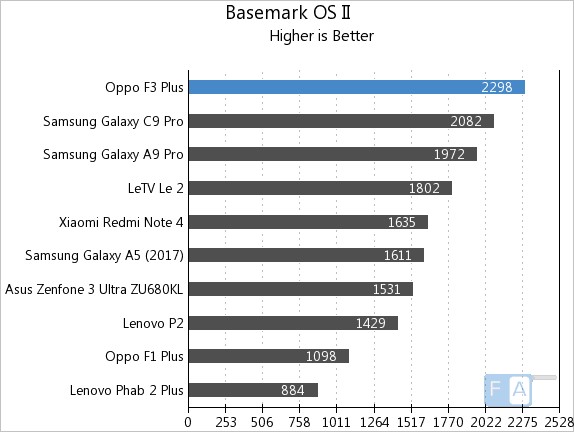
It topped the Basemark OS II benchmark by scoring 2298 points.
Camera

This is the party piece of the OPPO F3 Plus and the place where it is expected to shine the most. Let us start with the rear camera since it is the underdog on the phone at least. On paper though, the rear camera is a 16 Megapixel Sony IMX398 with 1/2.8″ sensor size with OIS and f1.7 aperture. That is pretty much as close to flagship territory as you can get on a mid-ranger smartphone.
In reality, the smartphone takes photos that are well detailed and even the low light performance is good. However, the dynamic range isn’t all that great. It can be improved to a certain extent using the HDR mode but even then, the highlights are often washed out. Now, it maybe wrong comparing it to the likes of the Pixel and iPhone 7. However, even compared to the likes of the OnePlus 3/3T, LG G5 and more, this smartphone seems to have a smaller dynamic range and that is possible the only issue I find with the rear camera.
The large aperture does let in a lot of light and the focusing is pretty fast. The colours are quite natural and the OIS does help to steady out the frame. There is an Ultra HD mode that takes several images and stitches them together to create a higher resolution image with more detailing. However, this is pretty much useless unless you are taking the photo with a tripod since the objects do appear more blurry when you zoom in due to the longer shutter times. Here are some samples:



Now onto the front facing camera or shall we say cameras since there are two on the F3 Plus. The primary one is the one you would be using for solo selfies. It is also a large sensor and comes in at 1/3″ in terms of size and is really close to the rear camera itself. The aperture however is a smaller f2.0. Nonetheless, the results you get from this front facing camera are brilliant. It carries a whole lot of detailing thanks to the 16 Megapixel resolution and lets in a lot of light. Enough to create a beautiful looking image in any lighting condition. The beauty mode takes it a step further and allows you to correct the imperfections on your skin to take the perfect selfie.

The secondary camera is an 8 Megapixel unit but comes with a much wider 120 degree field of view and hence is the group selfie camera. If you ever need to take a selfie with a group of friends or family, then this is the camera to use. It can accommodate a large group easily and has enough details for social media posts. You can even choose to take photos with the wider camera even if you are alone but need a bit more of the background to emphasize the importance of the selfie and your location.
Here are some photos taken with the regular front camera:
Here are some photos taken with the wide angle front facing camera:
There is also a bokeh mode that can be used with the regular selfie camera to blur out the background and put the focus back on you; both figuratively and literally. Finally, you can even take panorama shots with the front cameras in order to further expand your reach and accommodate more into one frame. However, in our experience, this is a bit tricky and even the slightest of movements can cause ghosting or improper stitching. There is also a nice double exposure mode that allows you to overlay two images to create a unique image. We haven’t seen many other smartphones offer this on the stock camera application but the OPPO F3 Plus does.

The F3 Plus can shoot videos in a maximum resolution of 4K at 30 fps. Despite the resolution, the videos really lack substance. The detailing is poor, the videos look washed out and the stabilization is poor as well. The front camera can take videos upto 1080p in resolution.
Music
The music player on the OPPO F3 Plus is quite simple yet provides a host of different ways to sort and listen to your music. It also supports various formats as well as Real HD sound technology that helps to improve the acoustic performance. In our experience, this enhances the bass and improves the clarity but the effect it had did vary from headphone to headphone. You can also fiddle with the equalizer to get the optimum audio experience to your liking.
The quality over the audio jack is quite good. There is more than enough volume and the sound is rich packing good bass as well as dynamic range. However, the loudspeaker isn’t that great and we feel that a smartphone of this size could’ve used a more powerful speaker at least if not a stereo speaker setup.
Battery Life

6″ 1080p display + 4000 mAh battery = Good battery life? Yes it does equate to that. The F3 Plus is by no means an endurance champion but it does do well and will last most heavy users over a day of usage with ease. That is tough to say with most smartphones these days and in my books, that is a huge bonus.

Whenever, you do run out of juice, you can top up the battery using VOOC Flash Charge technology. Note that you do need to use the stock charger in order to achieve the full charging speeds.

It achieved a One Charge Rating of 17 hours and 51 minutes in our battery test, mainly due to brilliant talk time. Check out the complete set of battery life test results here.
Conclusion

The OPPO F3 Plus as its name suggests is an outright selfie expert. There are a very few phones that can hold a torch to the front camera abilities of the F3 Plus and even the few that can would perhaps lose out on certain aspects such as detailing etc. The OPPO F3 Plus is a smartphone for those who love to click self-portraits; be it with their friends and/or family. Everything else is secondary. The rear camera is good but not class leading, the audio quality isn’t that great and the size is a bit big for many too. Overall, its a decent handset at best but it truly does excel at the selfie game and if that is your primary use case then this smartphone is the one for you. If not, then you would be better off looking at other options in the price range. The OPPO F3 Plus retails at around Rs 30,990 and is available on Amazon, Flipkart etc.
Pros
- Sturdy Build Quality and High Quality Materials
- Good Battery Life
- Good Performance
- Good Battery Life
- Excellent Front Camera Quality
Cons
- Size (Might be an issue for some)
- Display Sunlight Legibility is Poor
- Video Recording Quality is Not Very Good








